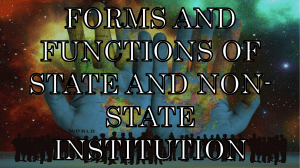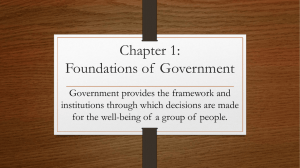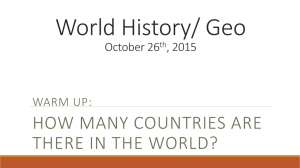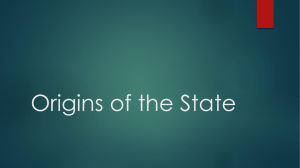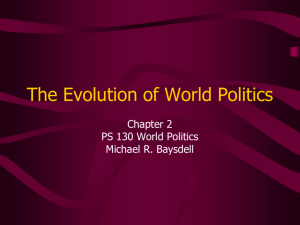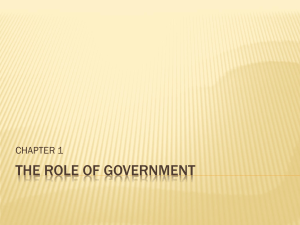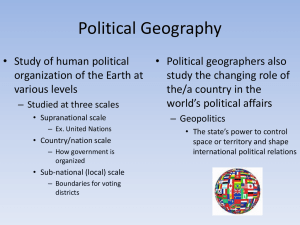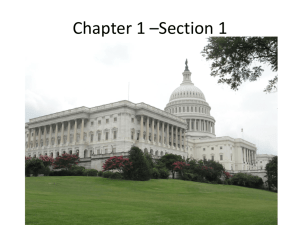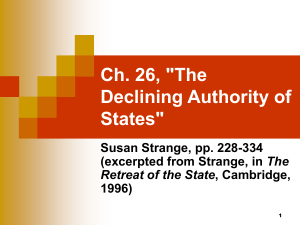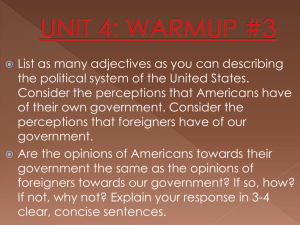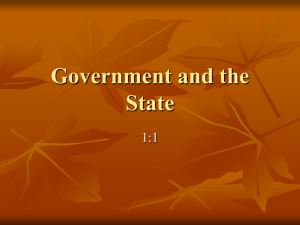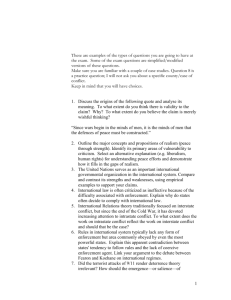Unit I PPT
advertisement
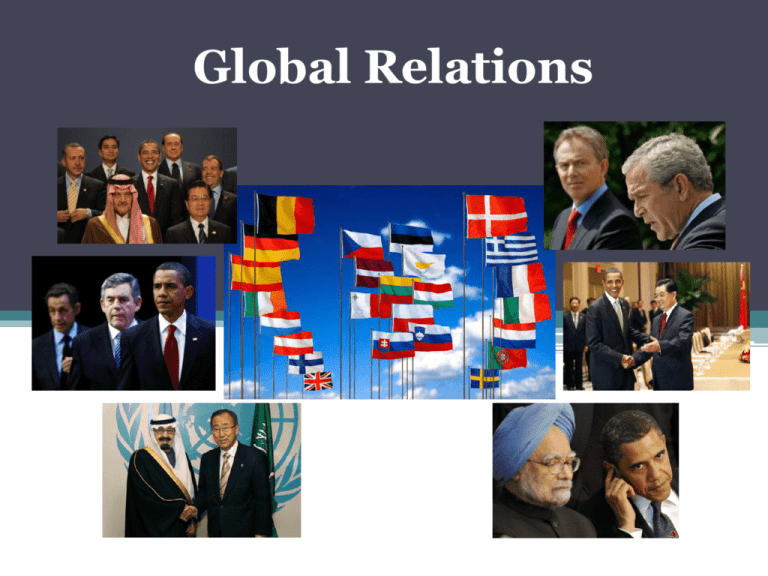
Global Relations Unit I: Introduction to International Relations Unit I: Introduction to International Relations Essential Questions • What is state sovereignty and how does it impact relations between states? • What are the three major ways that power can be distributed among the world’s states? • What are the major types of governments existing in the world today? International Relations is the study of what? How countries _ ? _ to / with each other. relate interact Guess the four key “C” words that fit in the blank. How countries _ ? _ to/with each other. cooperate communicate compete conflict Definitions of International Relations “The study of how countries relate to one another, how they work together, and how they conflict.” “The study of how states and non-state actors interact with and relate to each other.” There are 195 sovereign states in the world today. What’s another word for state? The terms state and country mean the same thing and can be used interchangeably. What is a State / Country? A self-governing political entity having: Territory with internationally recognized borders. A permanent population. A government. Sovereignty over its people and territory. External recognition from other states. The world’s newest state Name the country… • Largest? Russia • Smallest? Vatican City • Most populated? China • Newest? South Sudan • Richest? U.S. • Poorest? Burundi • Most visited? France • Most obese people? U.S. • Highest quality of life? Norway • Cleanest? Finland • Most Miss Universe & Miss World winners? Venezuela • Most billionaires? U.S. What is State Sovereignty? • The right of a state to determine and control what happens within its borders. • Means no other state has power or control over its territory. • Means governments are free to do what they want within their own state. Principle is often used by governments to keep others from interfering in their internal affairs. What’s a nation? • A group of people with a distinct identity. • What do members of a nation share in common? race ethnicity history culture language religion What’s a nation-state? A nation that has a state or country of their own. Examples * France Germany Egypt Japan Ireland Iceland Hungary Lebanon Mongolia Korea(s) Portugal Poland * Countries where more than 95% of the population is from same ethnic group. Some nations are without states Example: The Kurds are the world’s largest ethnic group in world without their own state. What’s the difference between interstate and intrastate? • Interstate (or International) “Between states” • Intrastate “Within a state” The Concept of Power Power in International Relations • What is power? Power refers to a state’s ability to influence the behavior of other states. • Why is power important? Powerful states are more likely to reach their foreign policy goals than less powerful states. The Distribution of Power in the World Balance of Power • A concept used in analyzing the distribution of power in the world. • When there is a balance of power, states enjoy relatively equal power and no one state dominates the others. The Balance of Power Theory of Politics The idea that states will adopt policies or form alliances meant to keep any one state or group of states from becoming too powerful. The Distribution of Power in the World A Unipolar System: • An international system dominated by one powerful state. • Describes the world over the last twenty years during which the U.S. has been the world’s only superpower. A Bipolar System: • An international system dominated by two major powers. • Most recently when? • Describes the Cold War system when there were two superpowers – the U.S. and the USSR. A Multipolar System: • An international system with multiple centers of power. • A rough balance of power exists between four or more states. • No state is dominant. Key Idea Relative Power Changes Over Time The Multipolar World of Tomorrow? World Governments What is Government? • The body of people that exercises power through the making and enforcement of public policy and laws within a state. • There are different types (or forms) of government based on who possesses that power. Types of Government Authoritarian Describes any government that requires obedience to the authority of one person or a small group of people. The people have little or no influence over decisions made by the government. Autocracies and dictatorships are authoritarian. Types of Government Autocracy (Autocratic government) Power is concentrated in the hands of one person. Types of Government Dictatorship A government in which absolute power is held by one person (a dictator), group, or political party. Types of Government Democracy • The people govern themselves directly or through elected representatives. • Representative democracies called republics. The World’s Democracies, 2012 Types of Government Monarchy • Power is held by a king or a queen. • Power is inherited through family blood lines. • Monarchs may hold absolute power or limited power (a constitutional monarchy). Types of Government Theocracy • Power is in the hands of religious leaders.
